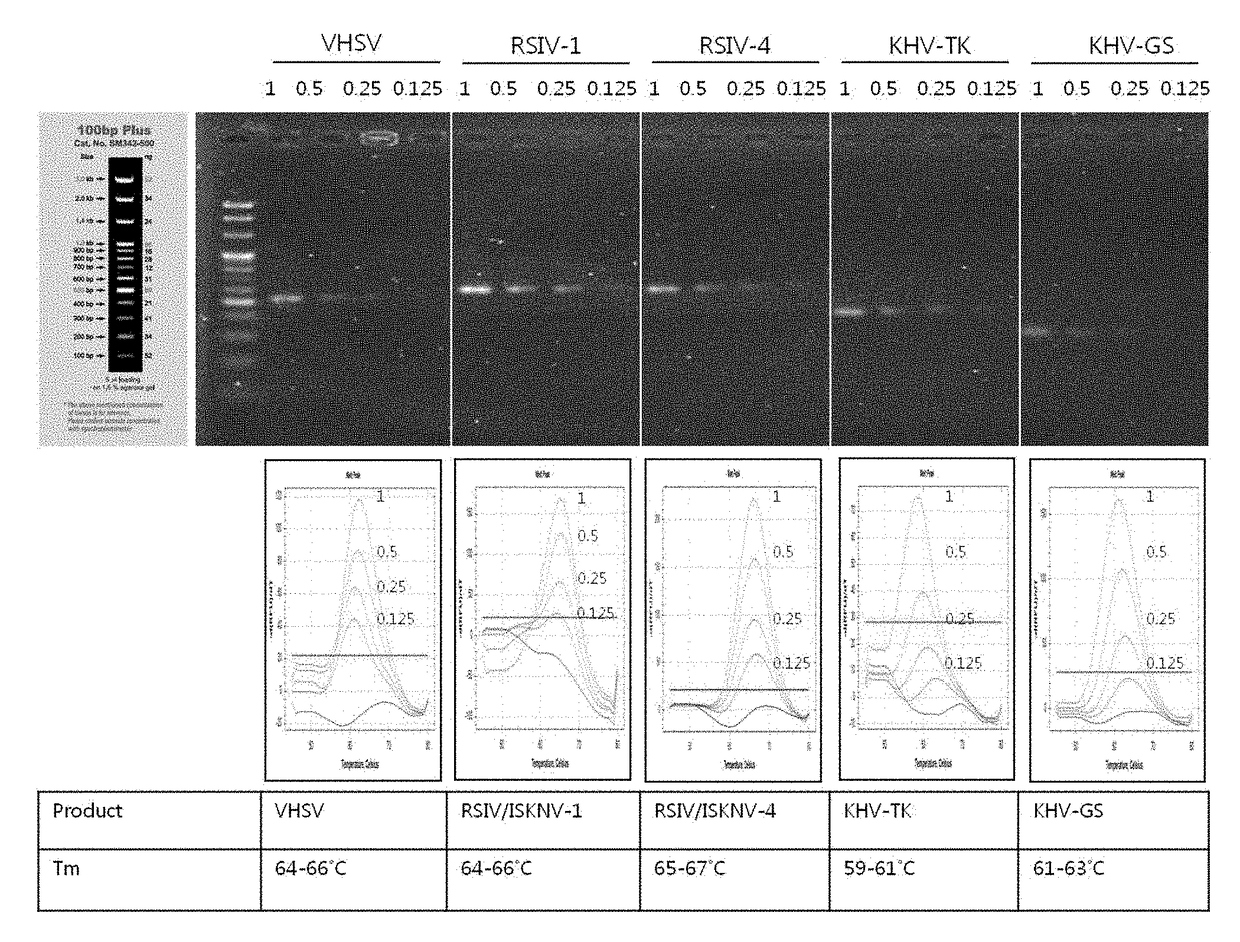Genetic markers for discrimination and detection of viruses causing infectious aquatic organism diseases, and method of discriminating and detecting the viruses using the same
a technology of infectious aquatic organisms and gene markers, which is applied in the field of gene markers for discrimination and detection of viruses causing infectious aquatic organism diseases, and the method of discriminating and detecting viruses using the same, can solve the problems of time-consuming analysis of disease diagnosis, unrecommended techniques, and complex procedures, and achieve the effect of increasing the temperature of a pna probe hybridized produ
- Summary
- Abstract
- Description
- Claims
- Application Information
AI Technical Summary
Benefits of technology
Problems solved by technology
Method used
Image
Examples
example 1
Construction of Genetic Markers for Discrimination and Detection of Viruses Causing Infectious Aquatic Organism Diseases, and Primers and PNA Probes Specific for the Viruses
[0119]1-1: Virus Causing Infectious Aquatic Organism Disease: VHSV
[0120]The sequence of a gene fragment, targeting the N-gene of VHSV and synthesized by “PCR method for detection according to the OIE standards”, was analyzed comparatively with the nucleotide sequence registered in the nucleotide database (DB) of the National Center for Biotechnology Information (NCBI) in order to obtain a gene nucleotide sequence for each type of virus.
[0121]As a result, the common nucleotide sequence of VHSV represented by 5′-GACATGGGCTTCA-3′ (SEQ ID NO: 11) was obtained, and the nucleotide sequence was selected as a genetic marker for discrimination or detection of VHSV.
[0122]Furthermore, as a primer for production of a single-strand DNA for the genetic marker, primer 1 represented by SEQ ID NO: 6 was constructed, and as a prob...
example 2
Optimization of MeltingArray Kit for Discrimination or Detection of Virus Causing Infectious Aquatic Organism Disease
[0146]Using PNA probes and primers constructed in Example 1, amplification curves and melting curves for DNA samples of four kinds of viruses causing infectious aquatic organism diseases were obtained and analyzed to verify PCR products, thereby optimizing the discrimination or detection of the disease-causing viruses. Herein, a TaqMan probe (and a conventional primer pair corresponding thereto) for discrimination or detection of the disease-causing viruses according to the OIE (Office of International Epizootics) standards may be used.
[0147]A MeltingArray reaction was performed using a CFX96™ real-time system (BIO-RAD, USA). To produce a single-strand target nucleic acid from the PCR product, a single-strand generation buffer (SSG buffer) and a single primer complementary to the binding strand of the probe were used. The composition of the SSG buffer comprised 2× nTa...
example 3
Method for Discriminating or Detecting Virus Based on Melting Peak Obtained Using PNA Probe
[0151]When the viral type for a unknown viral DNA sample is to be discriminated or detected using the PNA probes according to the present invention, a table listing scores at different melting temperatures as shown in Table 4 below can be previously prepared and can be used.
[0152]After melting curve analysis was performed as described in Example 2, the obtained fluorescence signal and Tm value were digitized according to the temperature at which a perfect match appeared. Specifically, the range of perfect match temperature ±2° C. is made, and when the Tm value for a unknown viral DNA sample is within this range, the type of virus in the viral sample can be identified and discriminated.
TABLE 4Fluorescent material ofPNA probeTm(° C.)Kind of detectable virusTexasRed65VHSV65RSIV, ISKNV66RSIV60KHV62KHV
[0153]Although the present invention has been described in detail with reference to the specific f...
PUM
| Property | Measurement | Unit |
|---|---|---|
| melting point | aaaaa | aaaaa |
| Tm | aaaaa | aaaaa |
| temperature | aaaaa | aaaaa |
Abstract
Description
Claims
Application Information
 Login to View More
Login to View More - R&D
- Intellectual Property
- Life Sciences
- Materials
- Tech Scout
- Unparalleled Data Quality
- Higher Quality Content
- 60% Fewer Hallucinations
Browse by: Latest US Patents, China's latest patents, Technical Efficacy Thesaurus, Application Domain, Technology Topic, Popular Technical Reports.
© 2025 PatSnap. All rights reserved.Legal|Privacy policy|Modern Slavery Act Transparency Statement|Sitemap|About US| Contact US: help@patsnap.com



